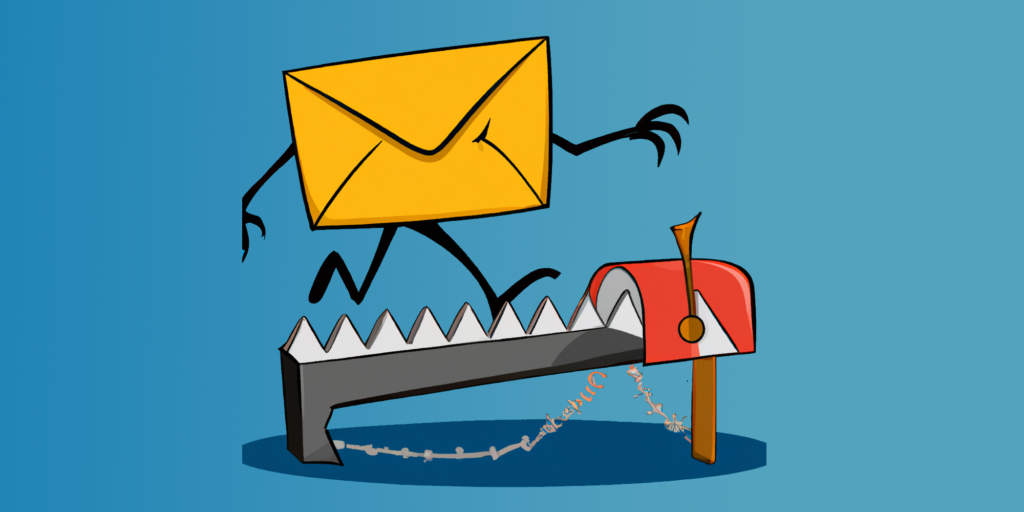Pretty much all email marketers at some point have had to face up with spam traps. They are hard to identify and can ralso damage your reputation as a sender. In this post I look at what a spam trap is, the different types of traps and how you can to deal with them.
What’s a spam traps?
Let’s start with what a spam trap is. You must have seen a movie or a show where the good guys are trying to catch the bad guys so they put out something the bad guy wants as bait. Bad guy goes for the bait and off to prison he goes. In this analogy the good guys are ISPs and spam institutes, a spam trap is the bait, you are the villainous creature and deliverability hell is the punishment.
Basically, a spam trap is an email address that never existed or no longer works, so if you send an email to it you’re likely using shady ways of gathering data or not cleaning your data.
Hold your horses though, hitting a spam trap isn’t the end of the world . There are different types of traps with different levels of severity.
Recycled traps
These type of spam traps are easy to fall into. A recycled trap is an email address that did once exist, belonged to a real person but has been inactive for a while. The likes of Microsoft will take over the email address and if you send an email to it they will assume you don’t keep your data clean and that could impact your deliverability. Given you’re not guilty of using nefarious means to capture data, this will not have a large impact on your deliverability unless you consistently hit them. So keep an eye on your deliverability and when you find yourself hitting traps start cleaning your data. Learn how to monitor your deliverability here.

Pristine traps
You need to avoid these like the plague. Pristine spam traps are email addresses that don’t belong to anyone. ISPs like Microsoft or spam institutes like Spamcop create spam traps. They then wait to see if anyone sends an email to their trap. If you do end up sending an email to it that will have severe consequences for your deliverability. If the trap belongs to a spam Institute, your IP address can be blacklisted. Given the email address never belonged to anyone, it couldn’t have been signed up to your list. So if you have hit a spam trap then review where you get your data from, and avoid email harvesters.
How to avoid spam traps
Spam traps are an email marketers worst nightmare. Do all you can to avoid getting one in your database. Recycled traps are hard to avoid but you can avoid pristine traps.
First tip, use a double opt-in. Basically, when someone subscribes on your website send them a verification email with a link to click. Those that click the link go into your database and those that don’t you simply don’t send anything more to. By doing this you ensure no one can maliciously add known spam traps into your database. This also makes sure you avoid capturing email addresses with typos, like me@hotmali.com. These sort of typos can also be spam traps so by using a double optin you keep them out of your database.
If you use third parties to gather data, check their sign up processes. Make sure they are verifying email addresses before providing them to you, or run your own verification on the data before paying the invoice.
You can also use email verification websites that offer real time validation of your sign ups. Just keep in my mind, their accuracy rates are around 98%. Nor can they identify all spam traps but they do have a list of known ones that they will check your data against. If you need an example of one, try ZeroBounce.net.
Cleaning your data of spam traps
If you have hit a spam trap you won’t be told what the email address is so you will need to put on your Sherlock hat and get investigating. First thing you want to do is figure out when you hit the trap. If the trap belongs to Microsoft you can use SNDS to find the date and time the trap was triggered. Learn more about SNDS here.

Identifying spam traps
– Identify the email addresses that received an email during that time frame.
– Given you are looking for a Microsoft trap, remove all other domains like Gmail and Yahoo
– Left with Microsoft addresses only, check your list against your opens
– A spam trap would not have opened the email so eliminate all the engagers
– From what you have left, find anyone that has never opened an email. One of them could be a pristine trap, so perhaps unsubscribe them for good?
– If none of the email addresses meet the last criteria, look for users that have not opened an email in the last 6 months
– Segment those email addresses next time you send an email and see if you hit a trap.
– Send an email to the excluded addresses, rinse and repeat this process until the list of potential traps is small enough for you to suppress and get rid of without costing you a large number of subscribers.
This is all very useful if you know the date and time the trap was hit, but Microsoft is the only one giving out this information. If you hit a spam trap owned by someone like Spamcop, all you will have to go on is the date you got blacklisted.
With such little information all you can do is:
– Isolate any new data you have gathered and remove it
– Cull anyone that has never opened an email
– Urgently review your data gathering practises and make them more robust
That’s everything to do with spam traps in a nutshell. If you have hit a spam trap and need help dealing with it drop me a line here.
Sign up to the newsletter and receive more content like this straight to your inbox.

